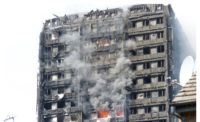Anish Kapoor and Cecil Balmond's "London Orbit" Rising Fast
Numerous structures are on course for completion in time for the London 2012 Summer Olympics, including a few that are uniquely shaped. Perhaps the strangest is a steelwork monument that will rise 114.5 meters, serving as an icon for the Olympic Park.


The red steelwork being built just outside the main stadium’s entrance, so far around 40 m tall, is the diagrid stem of the fantastic 15,000-tonne sculpture known as the Orbit.
The structure is the creation of U.K.-based artist Anish Kapoor and structural engineer Cecil Balmond, former deputy chairman of the engineering firm Arup Group. Ltd., London.
The team’s seemingly unstable tower/sculpture won a design competition in 2010 promoted by London Mayor Boris Johnson.
Like a loosely knotted rope frozen in space, Orbit’s diagrid tube will rise about 80 m to a 20-m-dia, two-floor observation deck, before twisting and turning around itself.
With constantly changing sectional dimensions in its roughly 500-m-long trajectory, the structure will be connected by steel brackets welded to points on the vertical tower. The snaking tube will be grounded at piled foundations at two points, forming its second and third structural legs.
Detailed design work began after the mayor procured in February 2010 a single donation covering 86% of Orbit’s $36-million budget from Lakshmi Mittal, chairman and CEO of Luxembourg-based steelmaker ArcelorMittal SA. The firm secured naming rights, dubbing the monument the ArcelorMittal Orbit.
To help develop Orbit’s shape, Arup’s engineers made extensive use of in-house 3D simulation software, says associate director Francis Archer. The entire design process was done “in the virtual world,” he adds. Because of the geometrical complexity, “you cannot show the structure in 2D drawing,” says Holger Falter, Arup’s associate responsible for the structural design.
“As soon as you freeze the geometry, you put in the loading, [which] allows you to dimension the structural members,” Falter says. His team used Arup’s GSA software program for analysis and design. The firm defined Orbit’s geometry—for use by the fabricator—with Tekla software, he adds.
Rising from a roughly 30-m-dia ring of pile caps, the vertical main steel diagrid—about 8.5 m in diameter—will enclose two elevators leading to the observation platforms. Emergency stairs, enclosed in steel mesh, will spiral down the diagrid’s exterior. A 40-tonne, pendulum-tuned mass damper will curb wind vibrations.
To get Orbit built, ArcelorMittal negotiated a design-build contract with Sir Robert McAlpine Ltd., Hemmel Hempstead, which leads construction of the stadium adjacent to the monument. Stadium subcontractor Watson Steel Structures Ltd., Bolton, is fabricating the steel, supplied by ArcelorMittal. A small team from Watson’s affiliate, Steelcraft Erection Services Ltd., Dalton, is putting up the diagrid.
Watson is fabricating the diagrid nodes as “stars,” each with six “arms.” Some of the “arms” for the diagrid are about two m long, including tubes with diameters of up to 51 centimeters. The “stars” are trucked as individual pieces to London, which is 320 km away.
Eight stars form each diagrid ring of the tower’s stem. Above the observation platform, the diagrid will have four nodes per level. These nodes reduce to some three meters across, small enough for Watson to weld into assemblies of four nodes.
To ensure a good fit, the fabricator pre-assembles whole sections of diagrid before dismantling them for transportation to the site.
The team began raising Orbit’s 570 stars with a mobile crane in late January. Each star is being bolted to preceding elements. For work at higher levels, the erectors will mobilize a 450-tonne-capacity crawler crane, with a 135-m-tall jib.
Piling was completed in October, allowing diagrid erection to start, with Watson fabricating eight stars a week. Despite its numerous elements, the structure is rising well within tolerances, says Chris Hall, McAlpine’s design manager. “If it starts going out of alignment, it’s difficult to get back,” he adds.
The tower is due for completion by summer, well before the July 2012 start of the games. After the games, it will be operated under a concession, expected to be awarded soon by its owner, the Olympic Park Legacy Co. The company expects that one million people a year will visit the structure after the dust of the Olympics settles and the park becomes a public space.
The ArcelorMittal Orbit will be the last project delivered of the more than 20 being built by the Olympic Delivery Authority (ODA) in the park and elsewhere in the U.K. With the Velodome handed over for use last month, 80% of venue work done and new grass growing in the park, ODA design director Alison Nimmo says, “We are very comfortable with where we are.”

